
Apidae is the largest family within the superfamily Apoidea, containing at least 5700 species of bees. The family includes some of the most commonly seen bees, including bumblebees and honey bees, but also includes stingless bees, carpenter bees, orchid bees, cuckoo bees, and a number of other less widely known groups. Many are valuable pollinators in natural habitats and for agricultural crops.

Myrtaceae, the myrtle family, is a family of dicotyledonous plants placed within the order Myrtales. Myrtle, pōhutukawa, bay rum tree, clove, guava, acca (feijoa), allspice, and eucalyptus are some notable members of this group. All species are woody, contain essential oils, and have flower parts in multiples of four or five. The leaves are evergreen, alternate to mostly opposite, simple, and usually entire. The flowers have a base number of five petals, though in several genera, the petals are minute or absent. The stamens are usually very conspicuous, brightly coloured, and numerous.

Megachilidae is a cosmopolitan family of mostly solitary bees. Characteristic traits of this family are the restriction of their pollen-carrying structure to the ventral surface of the abdomen, and their typically elongated labrum. Megachilid genera are most commonly known as mason bees and leafcutter bees, reflecting the materials from which they build their nest cells ; a few collect plant or animal hairs and fibers, and are called carder bees, while others use plant resins in nest construction and are correspondingly called resin bees. All species feed on nectar and pollen, but a few are kleptoparasites, feeding on pollen collected by other megachilid bees. Parasitic species do not possess scopae. The motion of Megachilidae in the reproductive structures of flowers is energetic and swimming-like; this agitation releases large amounts of pollen.

Halictidae is the second-largest family of bees with nearly 4,500 species. They are commonly called sweat bees, as they are often attracted to perspiration. Halictid species are an extremely diverse group that can vary greatly in appearance. These bees occur all over the world and are found on every continent except Antarctica. Usually dark-colored and often metallic, halictids are found in various sizes, colors and patterns. Several species are all or partly green and a few are red, purple, or blue. A number of them have yellow markings, especially the males, which commonly have yellow faces, a pattern widespread among the various families of bees. The family is one of many with short tongues and is best distinguished by the arcuate basal vein found on the wing. Females in this family tend to be larger than the males. They are the group for which the term 'eusocial' was first coined by entomologist, Suzanne Batra.

The term cuckoo bee is used for a variety of different bee lineages which have evolved the kleptoparasitic behaviour of laying their eggs in the nests of other bees, reminiscent of the behavior of cuckoo birds. The name is perhaps best applied to the apid subfamily Nomadinae, but is commonly used in Europe to mean bumblebees Bombus subgenus Psithyrus. Females of cuckoo bees are easy to recognize in almost all cases, as they lack pollen-collecting structures and do not construct their own nests. They often have reduced body hair, abnormally thick and/or heavily sculptured exoskeleton, and saber-like mandibles, although this is not universally true; other less visible changes are also common.
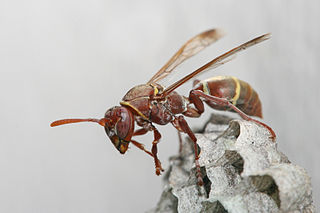
The Polistinae is a subfamily of eusocial wasps belonging to the family Vespidae. They are closely related to the wasps and true hornets of the subfamily Vespinae, containing four tribes. With about 1,100 species total, it is the second-most diverse subfamily within the Vespidae, and while most species are tropical or subtropical, they include some of the most frequently encountered large wasps in temperate regions.

The Colletidae are a family of bees, and are often referred to collectively as plasterer bees or polyester bees, due to the method of smoothing the walls of their nest cells with secretions applied with their mouthparts; these secretions dry into a cellophane-like lining. The five subfamilies, 54 genera, and over 2000 species are all evidently solitary, though many nest in aggregations. Two of the subfamilies, Euryglossinae and Hylaeinae, lack the external pollen-carrying apparatus that otherwise characterizes most bees, and instead carry the pollen in their crops. These groups, and most genera in this family, have liquid or semiliquid pollen masses on which the larvae develop.

The Oxaeinae are an exclusively American subfamily of the bee family Andrenidae, consisting of large (13–26 mm), fast-flying bees, often with large eyes. The four constituent genera, with a total of 19 described species, range from the United States to Argentina. Some resources still use the name Oxaeidae, and treat them as a family, but they were moved to subfamily status in 1995.
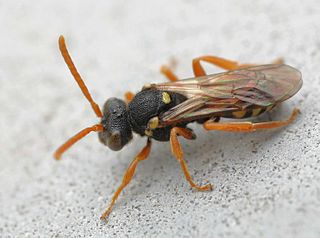
Nomadinae is a subfamily of bees in the family Apidae. They are known commonly as cuckoo bees.

The Apinae are the subfamily that includes the majority of bees in the family Apidae. It includes the familiar "corbiculate" bees—bumblebees, honey bees, orchid bees, stingless bees, Africanized bees, and the extinct genus Euglossopteryx. It also includes all but two of the groups that were previously classified in the family Anthophoridae.

The subfamily Chrysidinae contains those species that are most commonly recognized as cuckoo wasps, being by far the largest and most familiar subfamily. The group contains 3000 species with 48 genera worldwide. They are highly sculptured, with brilliantly metallic-colored bodies, covering the entire spectrum, but primarily blues and greens.
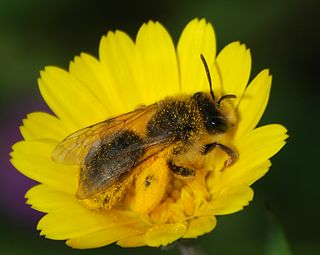
The Andrenidae are a large, nearly cosmopolitan family of solitary, ground-nesting bees. Most of the family's diversity is located in temperate or arid areas. It includes some enormous genera. One of the subfamilies, Oxaeinae, is so different in appearance that they were typically accorded family status, but careful phylogenetic analysis reveals them to be an offshoot within the Andrenidae, very close to the Andreninae.

Andrena is a genus of bees in the family Andrenidae. With over 1,500 species, it is one of the largest genera of animals. It is a strongly monophyletic group that is difficult to split into more manageable divisions; currently, Andrena is organized into 104 subgenera. It is nearly worldwide in distribution, with the notable exceptions of Oceania and South America. Bees in this genus are commonly known as mining bees due to their ground-nesting lifestyle.

The Galleriinae are a subfamily of snout moths and occur essentially worldwide, in some cases aided by involuntary introduction by humans. This subfamily includes the wax moths, whose caterpillars (waxworms) are bred on a commercial scale as food for pets and as fishing bait; in the wild, these and other species of Galleriinae may also be harmful to humans as pests.

Macrotera portalis is a species of communal, ground nesting, partially bivoltine bees found in arid grasslands and desert regions of North America. An oligolectic bee, M. portalis gathers pollen only from plants in the genus Sphaeralcea and has patterns of seasonal emergence to survive the harsh conditions of the desert, with emergence delayed until monsoon rains arrive.

Andrena antoinei is an extinct species of mining bee in the family Andrenidae described from a single fossil found in a Late Oligocene lake in present-day France that existed in semi-arid conditions.
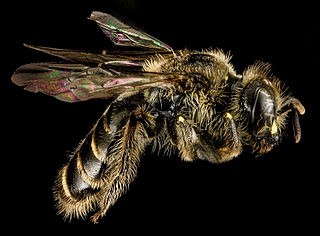
Calliopsis is a genus of panurgine bees in the family Andrenidae. There are over 80 described species distributed throughout the western hemisphere.
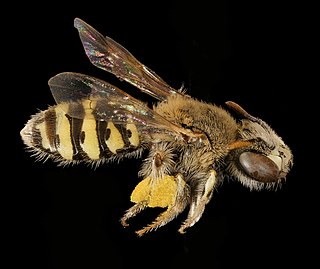
Calliopsini is a tribe of mining bees in the family Andrenidae. There are at least 120 described species in Calliopsini.

Protandrenini is a tribe of mining bees in the family Andrenidae. There are at least 12 genera and at least 380 described species in Protandrenini.
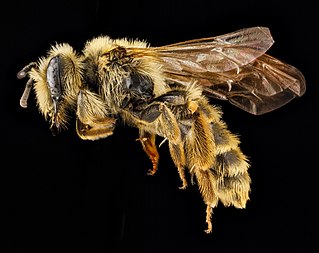
The death camas miner bee or death camas bee, is a species of miner bee in the family Andrenidae. It is found in North America. It specializes in feeding on the highly poisonous Toxicoscordion venenosum, the meadow deathcamas, and close relatives. It is quite likely the only bee that can tolerate the deathcamas toxin, zygacine.





















